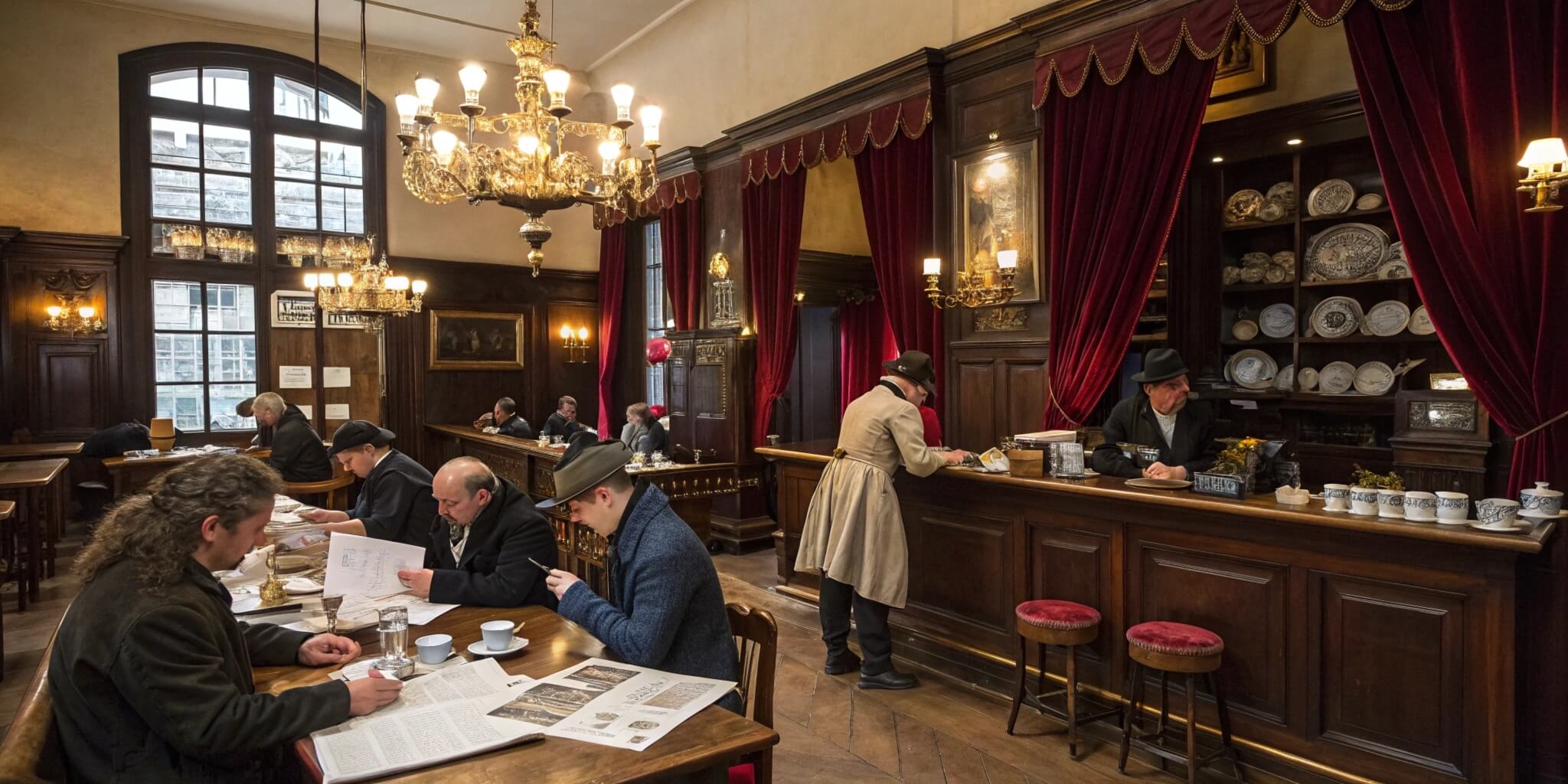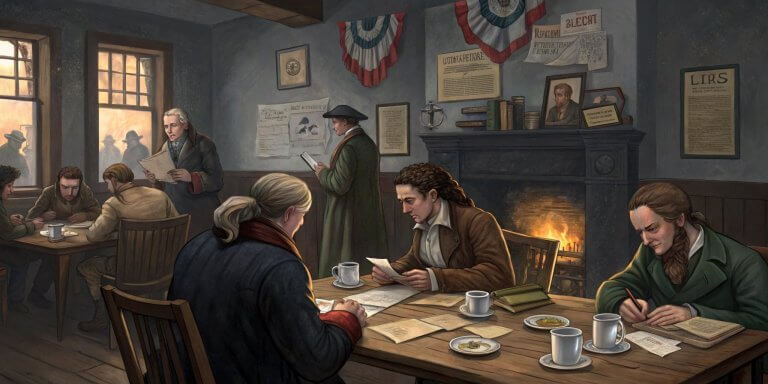
Coffeehouses have been more than just places to enjoy a hot drink; they were hubs of social interaction, politics, and culture. In Europe, particularly during the Enlightenment, coffeehouses became powerful spaces where new ideas flowed freely, people from different social classes mingled, and revolutions were brewed alongside coffee.
This article explores coffeehouses’ role in shaping social dynamics in Europe, drawing lessons from The Coffee House: A Cultural History by Markman Ellis and various other historical sources.
The Origins of Coffee Houses in Europe
The first European coffeehouses were established in Venice in the early 17th century. Traders who brought coffee from the Middle East introduced it to Europe, where it had long been a popular drink. These traders, mainly from Venice, played a crucial role in introducing coffee to European society. Soon, coffeehouses appeared in major cities like London, Paris, and Vienna.

From Venice to Paris: The Arrival of Coffee in 17th-Century Europe
Unlike taverns that served alcohol and often had a rowdier atmosphere, coffeehouses offered a sober, intellectual environment. This made them popular among thinkers, merchants, and scholars. The non-alcoholic nature of coffee allowed for more focused discussions, leading to a unique culture of debate and idea exchange
Coffeehouses as Centers of Enlightenment Thought
During the Enlightenment, coffeehouses were not just places to enjoy a cup of coffee. They were the epicenters of intellectual stimulation. In cities like London and Paris, these establishments were often called ‘penny universities.’ For the price of a cup of coffee—usually just a penny—people could enter and participate in discussions on a wide range of topics, from politics to philosophy. These discussions, fueled by the caffeine and the spirit of the times, often led to the birth of new ideas and the spread of knowledge.
Coffeehouses were not just about serving a hot cup of coffee. They were about breaking down social barriers and fostering inclusivity. Regardless of your social status, whether you were a scholar, a merchant, or a craftsman, you were welcome to contribute to the conversations. This inclusivity, rare in the highly stratified societies of the time, is often credited with fostering the intellectual environment that led to significant political revolutions, such as the American and French Revolutions.
Figures like Isaac Newton, Voltaire, and Jean-Jacques Rousseau were known to frequent coffeehouses, using them as spaces to share their ideas and engage with others. Coffeehouses were vital in shaping the public discourse central to the Enlightenment.
Coffeehouses and Political Discourse
Beyond their intellectual role, coffeehouses became centers for political conversation and dissent. During the English Civil War in the 17th century, coffeehouses were one of the few places where people could gather and discuss politics freely. They became so influential that King Charles II of England tried to suppress them, fearing they were breeding grounds for sedition.
Despite these attempts at suppression, coffeehouses continued to flourish and became key spaces for revolutionary discussions. In France, coffeehouses played a significant role in the lead-up to the French Revolution, as they were spaces where the middle class and intellectuals could meet and discuss revolutionary ideas without fear of immediate retribution. The open environment of the coffeehouse allowed for the spread of radical ideas that would later shape the course of European politics
Social Inclusion and Class Dynamics
One of the most remarkable aspects of coffeehouses was their ability to bring together people from all walks of life. Unlike the formal salons of the aristocracy, coffeehouses were open to anyone who could afford a cup of coffee. This included merchants, students, scholars, and sometimes even laborers. This mixing of social classes was revolutionary in its own right, as it allowed for the free exchange of ideas across social boundaries.
Women, however, were initially excluded from this environment. In some cities, women fought against these restrictions and began opening their own establishments or participating in private ‘coffee closets.’ Over time, societal norms shifted, and women became more involved in the coffeehouse culture, both as patrons and as owners. Their contributions to the intellectual and social life of coffeehouses were significant, and their inclusion transformed the dynamics of these spaces.
The Economic Role of Coffeehouses
Coffeehouses were not just about serving a hot cup of coffee. They were about fostering economic development. In London, coffeehouses became the meeting places for merchants and financiers, helping to create a space for monetary transactions. Some of Europe’s most important financial institutions, such as the London Stock Exchange and Lloyd’s of London, have their roots in coffeehouse meetings. These spaces were not just about intellectual and political life, but also about business and economic networking.
Merchants would gather in coffeehouses to discuss business, exchange information about trade routes, and even strike deals. Coffeehouses helped create an early form of networking that would later evolve into more formal economic institutions. This blend of social and economic functions made coffeehouses central to urban life in Europe
The Decline of Traditional Coffeehouses
By the 19th century, the role of traditional coffeehouses began to decline. The rise of mass media, particularly newspapers, reduced the need for people to gather in coffeehouses to access information. Industrialization also played a role, as people’s work schedules became more rigid, leaving them with less time to spend in coffeehouses. Additionally, the rise of restaurants and other forms of entertainment provided alternative spaces for social gatherings. However, the legacy of coffeehouses remained. Many institutions that originated in coffeehouses, such as financial markets and intellectual societies, continued to thrive even as the traditional coffeehouse culture faded.
However, the legacy of coffeehouses remained. Many of the institutions that originated in coffeehouses, such as financial markets and intellectual societies, continued to thrive even as the traditional coffeehouse culture began to fade
The Resurgence of Coffeehouse Culture in Modern Times
While traditional coffeehouses may have declined, the culture of coffeehouses has seen a revival in the late 20th and early 21st centuries. Modern coffee shops, particularly those associated with the third-wave coffee movement, have brought back many of the communal and intellectual aspects of the original coffeehouses. These modern coffeehouses focus on artisanal coffee, sustainability, and creating spaces for people to work, study, or engage in creative activities.

Breaking Barriers: Coffee Houses and the Mixing of Social Classes
The digital age has also transformed coffeehouses into hubs for remote workers and freelancers. With the rise of Wi-Fi and mobile technology, many coffee shops have become spaces where people can work outside the office, blending the traditional social function of the coffeehouse with modern needs.
Conclusion
Coffeehouses in Europe were far more than simple cafés. They were spaces where ideas flowed freely, revolutions were sparked, and social classes mingled in rare ways. From their origins in the 17th century to their modern resurgence, coffeehouses have remained integral to European social, intellectual, and political life. The lessons from these historical institutions show how public spaces dedicated to open discussion and community engagement continue to shape our world today.
The coffeehouse may have evolved, but its spirit of fostering communication, debate, and connection lives on.






